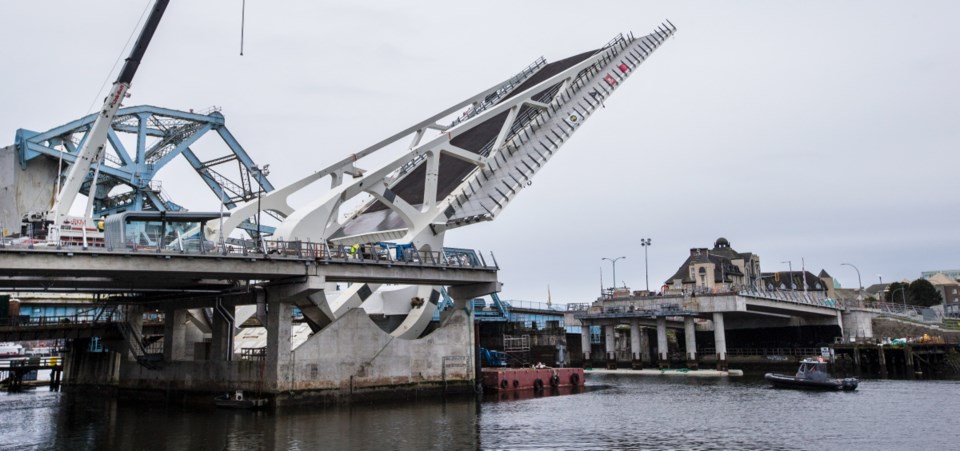Victoria is about to cut the ribbon on the largest single-leaf bascule bridge in Canada, and one of the largest in the world. But before politicians pop the champagne and celebrate our new “Grey Bridge,” taxpayers need to look at the mistakes made, and learn some lessons. It’s tempting to just move on, but we must ensure better value for our taxes in future.
In our view, the bridge project is the latest example of failed municipal governance leaving a significant financial legacy for the next generation to mop up. The final cost won’t be known for months, or years.
So, at this point, are we any wiser?
Victoria’s experience suggests that some municipalities have no idea how to keep a lid on project costs. In April 2009, when Victoria first decided to build a new bridge, the estimated cost was $40 million. A month later, when it applied for federal-provincial stimulus cash, the estimate was $63 million. The budget jumped to $77 million in 2010, $92.8 million in 2012 and now stands at $105 million — with council approving the increases every step of the way, instead of reducing the project’s scope or considering alternative designs.
By the way, those alarming cost increases resulted in the Canadian Taxpayers Federation awarding the city a Teddy Waste Award for the worst example of municipal-government waste in all of Canada.
Municipalities are also completely reliant on consultants for big projects. Victoria staff had no experience building movable bridges, so they hired MMM Group (now WSP). It pitched three designs in 2009, which were mechanically unusual and could entail greater risk. In 2012, staff and consultants urged council to sign a construction contract with only a four per cent contingency, a preliminary design and no penalties if the contractor blew the Dec. 31, 2015, completion deadline.
In addition, consultants don’t appear to suffer many consequences for giving such advice. The province’s cost guidelines for transportation infrastructure state that total project engineering costs “generally range from eight per cent to 12 per cent of the estimated total construction cost.” According to invoices posted on the city’s website, however, MMM/WSP has billed for about $15 million in fees, nearly 23 per cent of the new bridge’s $66-million construction budget.
Regionally, nothing has changed. There was no regional transportation plan or authority in 2009 to prioritize projects — and dampen Victoria’s urge to build an “iconic” bridge — and there still isn’t. Other municipalities have contributed nothing to the bridge project, even though it is a critical piece of regional infrastructure, like the McKenzie Interchange or Pat Bay Highway. Consequently, Victoria taxpayers have been stuck with all of the project’s cost increases.
Certainly, mismanagement of the project has had political consequences. Voters tossed three pro-replacement councillors in 2011, and in 2014, then-mayor Dean Fortin lost his job to Lisa Helps, who voted against the contingency-light construction contract. All of the staffers involved in the project’s early years have since retired or found jobs elsewhere.
Victoria claims it has already learned lessons from the bridge. The city has implemented a new cost-estimating policy (i.e. larger contingencies) and a project-management framework. Estimates for large-scale projects will be checked by a third party, and contract-writing has been improved.
But the city also appears to be repeating some of its mistakes, this time with the new Crystal Pool project. It is proceeding with designs, even though it has no real funding in place.
So, in the future, how can we ensure that municipalities such as the City of Victoria carry out megaprojects on budget and on time?
Civic self-examination and “lessons learned” exercises help, but they aren’t enough.
We are asking the provincial auditor general for local government to conduct a value-for-money audit of the “Grey Bridge” project. A performance audit would also help identify best practices for the benefit of all local governments.
While it might be a municipal election year — and Victoria’s council desperately wants the issue to go away — the public deserves a thorough accounting of what went wrong.
Stan Bartlett chairs Grumpy Taxpayer$ of Greater Victoria, a non-partisan advocacy group dedicated to lower taxes, less waste and more accountable municipal government. Ross Crockford is a director of johnsonstreetbridge.org, a local watchdog group.



